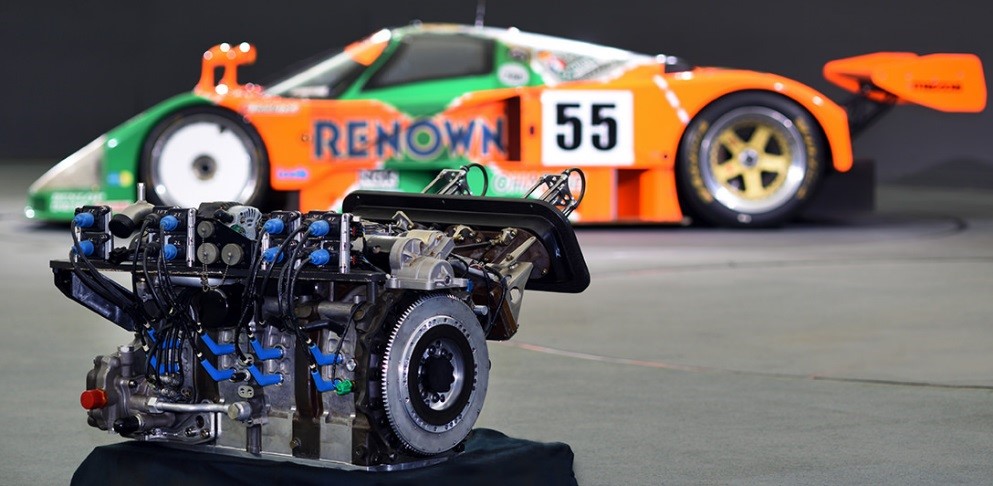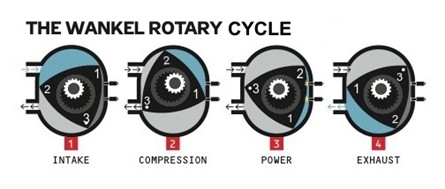
What engine is the Rotary Wankel: the Wankel engine is a type of internal combustion engine using an eccentric rotary design to convert pressure into rotating motion.
What is the Wankel displacement: it is in a range between 1308 cc and 3924 cc. The displacement given in engine specifications is typically for only one face of one rotor (a single working chamber), or one face multiplied by the number of rotors; however, all three faces of all rotors are working at the same time.
How much is the power of the Wankel engine: the power of the Wankel engine is in a range from 150 bhp to 280 bhp Which cars use Wankel engine: in recent production only Mazda on RX7, RX8 and Eunos Cosmo models. Compared to the reciprocating piston engine, the Wankel engine has more uniform torque; less vibration; and, for a given power, is more compact and weighs less. The rotor, which creates the turning motion, is similar in shape to a Reuleaux triangle, except the sides have less curvature. Wankel engines deliver three power pulses per revolution of the rotor using the Otto cycle. However, the output shaft uses toothed gearing to turn three times faster giving one power pulse per revolution. In one revolution, the rotor experiences power pulses and exhausts gas simultaneously, while the four stages of the Otto cycle occur at separate times. For comparison, in a two-stroke piston engine there is one power pulse for each crankshaft revolution (as with a Wankel engine output shaft) and, in a four-stroke piston engine, one power pulse for every two revolutions.
The four-stage Otto cycle of intake, compression, ignition, and exhaust occurs each revolution of the rotor at each of the three rotor faces moving inside the oval-like epitrochoidal housing, enabling the three power pulses per rotor revolution.

In the Wankel engine, the four strokes of an Otto cycle occur in the space between each face of a three-sided symmetric rotor and the inside of a housing. The oval-like epitrochoid-shaped housing surrounds a triangular rotor with bow-shaped faces similar in appearance to a Reuleaux triangle. The central drive shaft, called the eccentric shaft or E-shaft, passes through the center of the rotor being supported by fixed bearings. The rotors ride on eccentrics (analogous to crankpins in piston engines) integral to the eccentric shaft (analogous to a crankshaft). The rotors both rotate around the eccentrics and make orbital revolutions around the eccentric shaft. Seals at the apices of the rotor seal against the periphery of the housing, dividing it into three moving combustion chambers. Wankel engines ideally can reach much higher engine revolutions than reciprocating engines of similar power output. This is due partly to the smoothness inherent in its circular motion, lack of a mechanical valvetrain employing reciprocating poppet valves and the rotor spinning at one third of the speed of the output shaft. The design was conceived by German engineer Felix Wankel. Wankel received his first patent for the engine in 1929. He began development in the early 1950s at NSU, completing a working prototype in 1957. NSU subsequently licensed the design to companies around the world, that have continually made improvements. In 1951, NSU Motorenwerke AG in Germany began development of the engine, with two models being built. Mazda and NSU signed a study contract to develop the Wankel engine in 1961 and competed to bring the first Wankel-powered automobile to market. After years of development, Mazda's first Wankel-engine car was the 1967 Cosmo 110S. The company followed with a number of Wankel (rotary in the company's terminology) vehicles, including a bus and a pickup truck. Mazda later abandoned the Wankel in most of their automotive designs, continuing to use the engine in their sports car range only, producing the RX-7 until August 2002. The company normally used two-rotor designs. A more advanced twin-turbo three-rotor engine was fitted in the 1991 Eunos Cosmo sports car. In 2003, Mazda introduced the Renesis engine fitted in the RX-8. The Renesis engine relocated the ports for exhaust from the periphery of the rotary housing to the sides, allowing for larger overall ports, better airflow, and further power gains. The Renesis is capable of 238 hp (177 kW) with improved fuel economy, reliability, and lower emissions than previous Mazda rotary engines, all from a nominal 1.3-L displacement, but this was not enough to meet more stringent emissions standards. Mazda ended production of their Wankel engine in 2012 after the engine failed to meet the more stringent Euro 5 emission standards, leaving no automotive company selling a Wankel-powered vehicle. The company is continuing development of the next generation of Wankel engines, the SkyActiv-R. Mazda states that the SkyActiv-R solves the three key issues with previous rotary engines: fuel economy, emissions, and reliability.
Racing: in the racing world, Mazda has had substantial success with two-rotor, three-rotor, and four-rotor cars. Mazda was the first team from outside Western Europe or the United States to win Le Mans outright with the most outstanding racing car ever built the 787B. It was also the only non-piston engined car to win Le Mans, which the company accomplished in 1991 with their four-rotor 787B (2.622 L or 160 cu in—actual displacement, rated by FIA formula at 4.708 L or 287 cu in).
Source:
https://en.wikipedia.org/wiki/Wankel_engine
https://www.libralato.co.uk/technology/wankel.html
https://www.mazda.com/en/innovation/lemans30th/r26b/
edited by arrabbiata